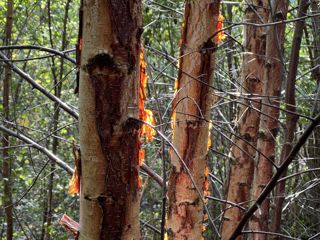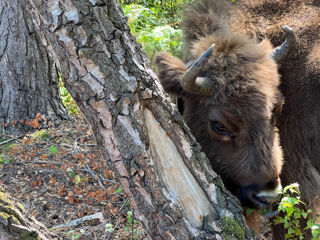
The project

What is the Blean bison project?
In 2019 Wildwood Trust and Kent Wildlife Trust launched a flagship wilding project, ‘Blean bison' in Blean woods near Canterbury. The project promotes stronger habitats by restoring natural processes that are able to withstand the current environmental crisis and species decline, and in the long run, reverse it.
In the UK, lack of woodland management is one of the eight biggest drivers of species decline. The Blean project aims to bring transformational change through a controlled trial with bison; a missing keystone species that is able to naturally manage woodlands.
A key part of this project was the extensive consultation and engagement with local landowners, interest groups and residents who know and love this area.
Although European bison were never native to the UK, Steppe Bison and other wild grazing animals once were. European bison are now our best chance at recreating those grazing behaviours that once existed. Despite their size, bison are peaceful animals whose ability to fell trees by rubbing up against them and eating the bark, gives space for other plants and animals to thrive. Bison will be accompanied by other grazing animals to create the greatest plant and animal diversity possible.

Where is it?
The project takes place in part of the West Blean woods nature reserve, which is in one of the largest areas of ancient woodland in the UK.
The wood is ever-changing and has an ancient droveway through it that is almost a thousand years old. Before Kent Wildlife Trust bought the wood, it was managed commercially for timber production, which is why almost half of the wood is covered in plantations of non-native conifer trees.

Why did we embark on this project?
In the UK, we’re headed for increasing species extinctions in the next 10 years. We know that the key to enabling species to survive and thrive is to create a nature recovery network, of bigger, better quality, and more joined up habitats
Species in the UK are declining at their fastest rate for thousands of years according to the latest State of Nature report and unfortunately human management alone is not enough to create the kinds of habitats species need.
What we need are natural solutions and this is why we have taken this first step to drive ‘Wilding’ at Wildwood Trust and in collaboration with Kent Wildlife Trust across some of their sites in Kent. Wilding is when nature is given the tools and space it needs to recover itself and has the potential to increase abundance of biodiversity to levels beyond what human management achieves and helps store carbon.
Join the future of UK wilding and help support our groundbreaking work by making a donation to the Blean bison project, adopting one of our animals or by booking an animal experience.
We encourage you to learn more about wilding and how it can help reverse the climate and nature crisis that we are currently in.
Please follow Wildwood Trust’s social pages and Kent Wildlife Trust’s social pages for updates on how you can get involved – both organisations will be posting updates via social media, website and emails.
Anyone can follow Wildwood Trust and Kent Wildlife Trust social media channels and subscribe to their newsletters for updates on how everyone can make sure their voice is heard. Updates will be posted across both organisations’ social media platforms.
The project team would love to hear from local people. As the project develops there will be many ways in which people can get involved, see below for a selection of what is to come.

